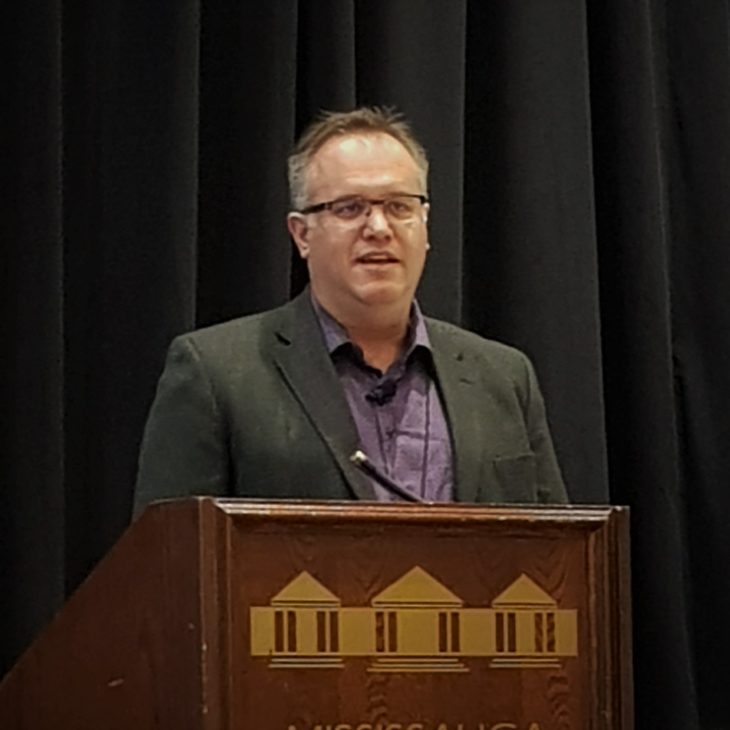
MISSISSAUGA – When it comes to the connected home and on-demand entertainment, today’s customer expects a “flawless experience,” but delivering that, with minimal disruption, means carriers must take a proactive approach to network maintenance.
In his keynote address at the Commtech East Show in Mississauga, James Myles (right), Rogers Communications director, service assurance GTA East, outlined how Proactive Network Maintenance (PNM) and data collection is evolving – and changing the game.
New architecture solutions, remote PHY, GPON, vCCAP and full duplex DOCSIS all create new possibilities to deliver new services to the customer. As a result there are now new performance indicators, different parameters to monitor and new actions to take. This means prioritization is once again the key to stay ahead of customer issues.
“[PNM is] really a process of peeling things back and finding the next layer of opportunities,” explained Myles. Part of that process is constantly re-evaluating processes to gain a better understanding of what areas need the most focus. He added Rogers is increasingly leveraging PNM data from CPE (customer premises equipment) devices and network elements to proactively address issues that are likely to impact a customer’s experience, hopefully before a customer sees a problem.
“When we started our journey with PNM a lot of information that we were looking at was related to microreflections [linear impairments] and CableLabs was putting out documentation that talked about using pre equalization data to help find problems. So we are using this data to find common faults like loose connectors, bad cables, things like that.”
Myles demonstrated how Rogers uses PNM tools to plot points on a map which visualize data retrieved from their modems, allowing technicians to identify clusters “that can lead us to a spot where we have a potential problem.”
In conversations with Comcast, Rogers found the optimal microreflection value was 27dB for finding issues with their single channel QAMs. By choosing a higher value they found they were often “chasing ghosts,” but he added once Rogers launched their OFDM DOCSIS 3.1 service they found they could also find certain issues by dialing the level up beyond 30 dB.
Beyond just data, Myles noted that PNM strategy must account for how seasonal changes can impact network performance, too.
“One thing I noticed recently, is we have this seasonal issue that comes up, and I kind of use this term that says, ‘you know when the tree sap runs the noise floor comes’.” Myles explained that in the early spring and fall networks come under pressure from rapid swings in temperatures which can cause sudden contraction and expansion.
These types of issues can be very difficult to track down as they may appear at “3 a.m. and by the time the technician gets there in the morning its warmed up enough that the trouble has disappeared,” he explained.
As Rogers activates additional, advanced, DOCSIS 3.1 devices, the company is beginning to get richer content to help technicians understand what's happening in the OFDM spectrum, added Myles.
“When it's a congestion issue that’s related to impairment then we need a tow truck to clear the way.” – James Myles, Rogers Cable
“We have a sort of a stamp of approval when we finish up PNM activity where we look for a node to be performing better than 90%. So, the next step for us is how can we take that last 10% and run them through the other programs, to address issues in the home so we leave no customers behind?”
Myles finished by comparing congestion and RF signal quality to highway congestion.
“So if you picture a 401 multi-lane highway there are two reasons it becomes congested. The first of which is there's just too many cars for the lanes and the other reason is, there's an accident in the express lanes and it diverts everybody off to the collectors. So on the DOCSIS front we have different ways of handling congestion issues, if we have an overall pipe capacity issue then we need to do a lane extension and we need to add capacity. When it's a congestion issue that’s related to impairment then we need a tow truck to clear the way.”
“Prioritization is key,” concluded Myles. What parameters are the most important to maintain that best possible customer experience.”
He says technicians need to focus on clearly correlating network information so they “spend less time finding and more time fixing.”
“In the past you heard comments like ‘I don't know what the tech is doing, he is spending all his time sitting in his truck, playing on his laptop. However, he’s probably the smart one who is figuring out how he can take his ladder off the truck once, instead of five times.”



